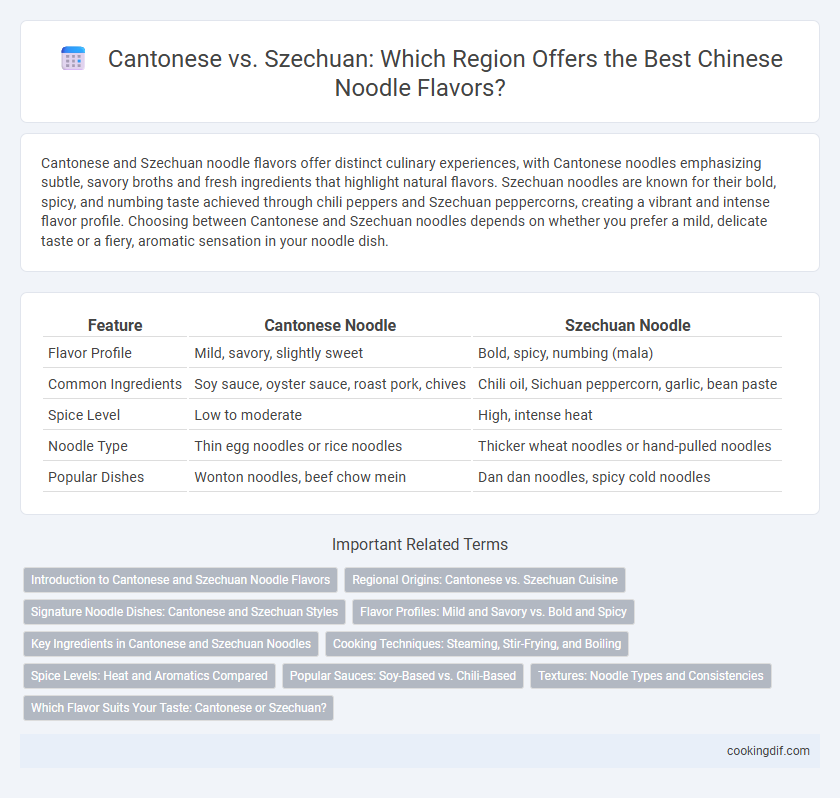Cantonese and Szechuan noodle flavors offer distinct culinary experiences, with Cantonese noodles emphasizing subtle, savory broths and fresh ingredients that highlight natural flavors. Szechuan noodles are known for their bold, spicy, and numbing taste achieved through chili peppers and Szechuan peppercorns, creating a vibrant and intense flavor profile. Choosing between Cantonese and Szechuan noodles depends on whether you prefer a mild, delicate taste or a fiery, aromatic sensation in your noodle dish.
Table of Comparison
| Feature | Cantonese Noodle | Szechuan Noodle |
|---|---|---|
| Flavor Profile | Mild, savory, slightly sweet | Bold, spicy, numbing (mala) |
| Common Ingredients | Soy sauce, oyster sauce, roast pork, chives | Chili oil, Sichuan peppercorn, garlic, bean paste |
| Spice Level | Low to moderate | High, intense heat |
| Noodle Type | Thin egg noodles or rice noodles | Thicker wheat noodles or hand-pulled noodles |
| Popular Dishes | Wonton noodles, beef chow mein | Dan dan noodles, spicy cold noodles |
Introduction to Cantonese and Szechuan Noodle Flavors
Cantonese noodle flavors emphasize delicate, light broths with subtle seafood and soy sauce notes, highlighting freshness and umami balance. Szechuan noodles deliver bold, spicy profiles enriched with chili oil, Sichuan peppercorns, and garlic, creating a numbing and intensely flavorful experience. These distinct regional styles reflect diverse Chinese culinary traditions, appealing to varying spice tolerance and flavor preferences.
Regional Origins: Cantonese vs. Szechuan Cuisine
Cantonese noodles are characterized by their light, savory broths flavored with ingredients like soy sauce, oyster sauce, and fresh seafood, reflecting the coastal influences of southern China. Szechuan noodles, originating from Sichuan Province, feature bold, spicy flavors driven by the use of Sichuan peppercorns, chili oil, and garlic, creating a numbing and fiery taste profile. The distinct regional origins influence not only the spice levels but also the herbal and aromatic components that define each noodle's unique flavor experience.
Signature Noodle Dishes: Cantonese and Szechuan Styles
Cantonese noodle dishes highlight delicate, savory flavors with light soy-based sauces and fresh seafood or barbecue meats, emphasizing smooth textures and subtle seasoning. Szechuan noodles are renowned for their bold, spicy profiles, featuring chili oil, Sichuan peppercorns, and intense, numbing heat that create a complex sensory experience. Signature dishes include Cantonese wonton noodles and Szechuan dan dan noodles, each representing distinct regional tastes and culinary techniques in Chinese noodle culture.
Flavor Profiles: Mild and Savory vs. Bold and Spicy
Cantonese noodles showcase mild and savory flavor profiles characterized by light soy sauce, oyster sauce, and subtle aromatics that enhance the natural umami without overwhelming the palate. In contrast, Szechuan noodles are bold and spicy, featuring Sichuan peppercorns, chili oil, and garlic that deliver a numbing heat and complex, fiery taste. These distinct flavor profiles cater to different preferences, with Cantonese cuisine emphasizing delicate balance and Szechuan offering intense, vibrant sensations.
Key Ingredients in Cantonese and Szechuan Noodles
Cantonese noodles are characterized by a light soy sauce base, incorporating key ingredients like oyster sauce, ginger, garlic, and scallions, which deliver a delicate and savory flavor profile. In contrast, Szechuan noodles emphasize bold and spicy elements utilizing chili oil, Sichuan peppercorns, garlic, and fermented bean paste, creating a numbing heat and complex taste experience. Both styles highlight unique regional ingredients that define their distinctive noodle flavor profiles.
Cooking Techniques: Steaming, Stir-Frying, and Boiling
Cantonese noodles emphasize delicate steaming and boiling techniques that preserve the noodles' smooth texture and highlight subtle, savory flavors, often paired with light soy-based sauces. Szechuan noodles, by contrast, rely heavily on stir-frying with bold, spicy ingredients like chili oil and Sichuan peppercorns, creating a complex, numbing flavor profile. The contrast in cooking methods--gentle steaming and boiling versus intense stir-frying--defines the distinct taste and mouthfeel unique to each regional noodle style.
Spice Levels: Heat and Aromatics Compared
Cantonese noodle dishes emphasize subtle spice levels, highlighting aromatic flavors like ginger, scallions, and mild soy-based sauces, creating a balanced and delicate taste profile. Szechuan noodles, in contrast, feature intense heat and bold aromatics, utilizing Sichuan peppercorns, chili oil, and garlic to deliver a numbing spiciness and complex flavor depth. The heat level in Szechuan cuisine can range from moderate to extreme, appealing to those who prefer a vibrant, fiery noodle experience over the more restrained Cantonese style.
Popular Sauces: Soy-Based vs. Chili-Based
Cantonese noodles feature popular soy-based sauces like light soy sauce and oyster sauce, emphasizing umami and subtle sweetness to complement fresh ingredients. Szechuan noodles prominently use chili-based sauces, such as chili oil and doubanjiang, delivering bold, spicy, and numbing flavors distinctive to the region. The contrast in sauce bases defines the noodle experience, with Cantonese favoring savory, mild tastes and Szechuan offering intense, fiery heat.
Textures: Noodle Types and Consistencies
Cantonese noodles typically feature thin, smooth egg noodles with a springy, slightly chewy texture that complements delicate broths and light sauces. Szechuan noodles often use thicker, hand-pulled or knife-cut varieties with a firmer, more robust bite that holds up well to spicy, oily, and intensely flavored sauces. The contrasting noodle textures highlight the regional flavor profiles, with Cantonese emphasizing subtlety and Szechuan focusing on boldness and complexity.
Which Flavor Suits Your Taste: Cantonese or Szechuan?
Cantonese noodle flavors emphasize subtle, delicate seasonings with light soy sauce, seafood, and fresh vegetables, appealing to those who prefer mild, umami-rich dishes. Szechuan noodle flavors are bold and spicy, featuring chili oil, Sichuan peppercorns, and garlic, perfect for enthusiasts of fiery, numbing heat. Choosing between Cantonese and Szechuan noodles depends on whether you favor smooth, savory tastes or intense, spicy sensations.
Cantonese vs Szechuan for Chinese noodle flavor Infographic

 cookingdif.com
cookingdif.com